Temporal and Spatial Variation Characteristics of Precipitation in the Haihe River Basin under the Influence of Climate Change
Abstract
1. Introduction
2. Data and Methods
2.1. Overview of the Study Area
2.2. Data Sources
2.3. Research Methods
2.3.1. The Mann–Kendall Test
2.3.2. Spearman’s Correlation Analysis
3. Results and Discussion
3.1. Temperature Trend Analysis and Significance
3.1.1. Analysis of Annual Mean Temperature Changes
3.1.2. Analysis of Average Temperature Changes for Different Seasons
3.2. Precipitation Trend Analysis and Significance
3.2.1. Analysis of Annual Precipitation Changes
3.2.2. Analysis of Precipitation Changes for Different Seasons
3.3. Spearman’s Correlation Analysis Results
3.3.1. Analysis of the Correlation between Annual Mean Temperature and Annual Precipitation
3.3.2. Analysis of the Correlation between Mean Temperature and Precipitation for Different Seasons
4. Conclusions
Author Contributions
Funding
Institutional Review Board Statement
Informed Consent Statement
Data Availability Statement
Acknowledgments
Conflicts of Interest
References
- Zhang, L.; Chen, X.; Zhao, Z.; Hu, Z. Progress in Study Change Impacts on Hydrology and Water Resources. Prog. Geogr. 2008, 3, 60–67. [Google Scholar]
- IPCC. The Physical Science Basis.Contribution of Working Group I to the Fifth Assessment Report of the Intergovernmental Panel on Climate Change; Cambridge University Press: Cambridge, UK; New York, NY, USA, 2013. [Google Scholar]
- Held, I.M.; Soden, B.J. Robust Responses of the Hydrological Cycle to Global Warming. J. Clim. 2006, 19, 5686–5699. [Google Scholar] [CrossRef]
- Allen, M.R.; Ingram, W.J. Constraints on Future Changes in Climate and the Hydrologic Cycle. Nature 2002, 419, 224–232. [Google Scholar] [CrossRef]
- Dore, M.H.I. Climate Change and Changes in Global Precipitation Patterns: What Do We Know? Environ. Int. 2005, 31, 1167–1181. [Google Scholar] [CrossRef]
- Hsu, P.C.; Li, T.; Wang, B. Trends in Global Monsoon Area and Precipitation over the Past 30 Years. Geophys. Res. Lett. 2011, 38. [Google Scholar] [CrossRef]
- Greve, P.; Orlowsky, B.; Mueller, B.; Sheffield, J.; Reichstein, M.; Seneviratne, S.I. Global Assessment of Trends in Wetting and Drying over Land. Nat. Geosci. 2014, 7, 716–721. [Google Scholar] [CrossRef]
- Xu, D.; Li, J.; Zhou, Z.; Liu, J.; Yan, Z.; Wang, D. Study on the Spatial and Temporal Distribution of Precipitation Characteristics in China from 1956 to 2018. Water Resour. Hydropower Eng. 2020, 51, 20–27. [Google Scholar]
- Chen, J.; Liu, Y.; Pan, T.; Wu, S.; Tan, Q.; Ge, Q.; Liu, Y. Spatiotemporal Variation of Precipitation in China and Its Impact on Surface Dry-Wet Conditions During 1961–2010. J. Nat. Resour. 2019, 34, 2440–2453. [Google Scholar]
- Xu, X.; Zhang, X.; Dai, E.; Song, W. Research of Trend Variability of Precipitation Intensity and Their Contribution to Precipitation in China from 1961 to 2010. Geogr. Res. 2014, 33, 1335–1347. [Google Scholar]
- Wu, Y.; Wu, S.; Wen, J.; Xu, M.; Tan, J. Changing Characteristics of Precipitation in China During 1960–2012. Int. J. Climatol. 2016, 36, 1387–1402. [Google Scholar] [CrossRef]
- Wang, F.; Yang, S.; Wayne, H.; Li, Q.; Zuo, Z. Long-Term Changes in Total and Extreme Precipitation over China and the United States and Their Links to Oceanic–Atmospheric Features. Int. J. Climatol. 2014, 34, 286–302. [Google Scholar] [CrossRef]
- Liu, K.; Nie, G.; Zhang, S. Study on the Spatiotemporal Evolution of Temperature and Precipitation in China from 1951 to 2018. Adv. Earth Sci. 2020, 35, 1113–1126. [Google Scholar]
- Zhao, D.; Gao, X.; Wu, S.; Zheng, D. Trend of Climate Variation in China 1960 to 2018 Based on Natural Regionalization. Adv. Earth Sci. 2020, 35, 750–760. [Google Scholar]
- Fischer, T.; Gemmer, M.; Lüliu, L.; Buda, S. Temperature and Precipitation Trends and Dryness/Wetness Pattern in the Zhujiang River Basin, South China, 1961–2007. Quat. Int. 2011, 244, 138–148. [Google Scholar] [CrossRef]
- Chen, T.; Ao, T.; Li, X. Temporal and Spatial Variation of Air Water Resources in the Yangtze River Basin in Recent Seventy Years. China Rural Water Hydropower 2019, 5, 6–11. [Google Scholar]
- Li, J.; He, X.; Hu, S. Multi-Time Scale Stochastic Characteristics and Regionalization of Monthly Precipitation in the Yangtze River Basin. Resour. Environ. Yangtze Basin 2021, 30, 111–121. [Google Scholar]
- Tan, Y.; Qiu, X.; Zeng, Y.; Shi, G. Variation Trend of Precipitation in Different River Basins in Recent 50 Years. J. Meteorol. Sci. 2016, 36, 494–501. [Google Scholar]
- Wang, K.; Qian, M.; Xu, S.; Liang, S.; Chen, H.; Hu, Y.; Su, C.; Zhao, M.; Li, W.; Wang, J. Impacts of Climate Change on Water Resources in the Huaihe River Basin. MATEC Web Conf. 2018, 246, 01090. [Google Scholar]
- Yu, Z.; Song, Y.; Wei, J.; Hu, S.; Xux, Q. The 70 Years’ Governance Process of Haihe River [J/OL]. Res. Environ. Sci. Res. 2021, 1–16. [Google Scholar] [CrossRef]
- Ren, X.; Hu, Z.; Cao, Y.; He, S. Evaluation of Water Resources in the Haihe River Basin; China Water & Power Press: Beijing, China, 2004; pp. 21–35. (In Chinese) [Google Scholar]
- Wang, L.; Zhu, H.; Lu, F.; He, L. Characteristics of Temporal and Spatial Variation of Precipitation in Haihe River Basin during Recent 50 Years. Agric. Res. Arid Areas 2012, 30, 242–246. [Google Scholar]
- Hao, Z.; Yan, L.; Ju, Q.; Dun, Z. Spatiotemporal Characteristics of Climate Variation in Different Kinds of Landforms of Haihe River Basin. Res. Soil Water Conserv. 2014, 21, 56–60. [Google Scholar]
- Liu, B.; Yan, Z.; Sha, J.; Li, S. Drought Evolution Due to Climate Change and Links to Precipitation Intensity in the Haihe River Basin. Water 2017, 9, 878. [Google Scholar] [CrossRef]
- Yan, Z.; Wang, S.; Ma, D.; Liu, B.; Lin, H.; Li, S. Meteorological Factors Affecting Pan Evaporation in the Haihe River Basin, China. Water 2019, 11, 317. [Google Scholar] [CrossRef]
- Yu, Y.; Yang, Z.; Liu, Y.; Din, D.; Liu, J. Review of Study on Precipitation of Haihe River Basin under Changing Environment. J. China Hydrol. 2010, 30, 32–35. [Google Scholar]
- Sun, Y.; Liu, Q.; Li, Q.; Yuan, X. Temporal Variation of Precipitation Characteristics in Haihe Basin during Recent 60 Years. Water Resour. Res. 2019, 8, 117–124. [Google Scholar] [CrossRef]
- Yu, L.; Yang, J.; Xu, L.; Hu, G.; Hu, H.; Zhang, T.; Gao, M.; Li, Z. Trend and Drying Characteristics of Haihe River Basin under the Background of Climate Change. J. Jilin Univ. (Earth Sci. Ed.) 2014, 44, 1615–1624. [Google Scholar]
- Zhang, J.; Qiao, Q. Influence Mechanism Analysis of Climate Changes on Precipitation of the Haihe River Basin. S. North. Water Transf. Water Sci. Technol. 2009, 7, 77–80. [Google Scholar]
- Yan, X.; Zhang, J.; Bao, Z.; Wang, G.; Guan, T. Evolution of Drought and Flood in the Haihe River Basin for the Last 500 Years. Hydro-Sci. Eng. 2020, 4, 17–23. [Google Scholar]
- Shao, Y.; Liu, L.; Liu, J.; Wu, J. Frequency Analysis and Its Spatiotemporal Characteristics of Precipitation Extremes in the Haihe River Basin During 1951–2010. Trans. Atmos. Sci. 2020, 43, 381–391. [Google Scholar]
- Bao, Z.; Zhang, J.; Yan, X.; Wang, G.; He, R.; Guan, T.; Liu, Y. Quantitative Assessment of the Attribution of Runoff Change Caused by Four Factors in the Haihe River Basin [J/OL]. Adv. Water Sci. 2021, pp. 1–11. Available online: http://kns.cnki.net/kcms/detail/32.1309.P.20201216.1651.004.html (accessed on 16 April 2021).
- Jian, H.; Luo, Y.; Xie, D. Precipitation Variation Feature Research Based on Mann-Kendall and Wavelei Analysis—Taking the Shapingba in Chongqing as an Example. J. Southwest China Norm. Univ. (Nat. Sci. Ed.) 2011, 36, 217–222. [Google Scholar]
- Kang, S.; Zhang, B.; Liu, J.; Yang, M. Analysis of the Spatiotemporal Distribution of Precipitation in Zhangye City Using Mann-Kendall Method. Resour. Sci. 2009, 31, 501. [Google Scholar]
- Kendall, M.G. Rank Correlation Measures; Charles Griffin: London, UK, 1975. [Google Scholar]
- Kottegoda, N.T. Stochastic Water Resources Technology; Wiley: New York, NY, USA, 1980; ISBN 978-1-349-03467-3. [Google Scholar]
- Burn, D.H.; Hag Elnur, M.A. Detection of Hydrologic Trends and Variability. J. Hydrol. 2002, 255, 107–122. [Google Scholar] [CrossRef]
- Abdul Aziz, O.I.; Burn, D.H. Trends and Variability in the Hydrological Regime of the Mackenzie River Basin. J. Hydrol. 2006, 319, 282–294. [Google Scholar] [CrossRef]
- Mishra, A.K.; Singh, V.P. Changes in Extreme Precipitation in Texas. J. Geophys. Res. 2010, 115, D14. [Google Scholar] [CrossRef]
- Mann, H.B. Non-Parametric Tests against Trend. Econometrica 1945, 13, 245–259. [Google Scholar] [CrossRef]
- Liu, Z.; Xu, D.; Wei, X.; Wang, X.; Liang, Z.; Jiang, X. Variation Characteristics of the Precipitation Structure during the Rainy Season in the Beijiang River Basin, China. Trop. Geogr. 2020, 40, 145–153. [Google Scholar]
- Dong, Z.; Peng, T.; Dong, X.; Liu, J.; Chang, W.; Lin, Q. Spatiotemporal Variation Characteristics of Extreme Precipitation Events in the Three Gorges Reservoir Area During 1960–2016. J. Water Resour. Water Eng. 2020, 31, 93–101. [Google Scholar]
- Fei, L.; Deng, G.; Zhang, H.; Guo, X.; Wang, X. Spatiotemporal Patterns of Precipitation and Drought and Flood Using Z-Index in Democratic People’s Republic of Korea. J. Nat. Resour. 2020, 35, 3051–3063. [Google Scholar]
- Tu, Q. Probability Statistics Is Applied to Meteorology; Meteorological Press: Beijing, China, 1984; pp. 222–229. [Google Scholar]
- Myers, J.J.; Well, A.D. Research Design and Statistical. Analysis; Lawrence Erlbaum: Abingdon, UK, 2003. [Google Scholar]
- Maritz, J.S. Distribution-Free Statistical Methods, 1st ed.; Chapman & Hall: New York, NY, USA, 1981; ISBN 978-0-412-15940-4. [Google Scholar]
- Xie, W. Variable Screening Based on Spearman Correlation. Master’s Thesis, Beijing University of Technology, Beijing, China, 2015. [Google Scholar]
- Wang, Q.; Feng, S. The Demonstration and Application about Calculating Formula of Spearman Coefficient. J. Shanxi Agric. Univ. (Soc. Sci. Ed.) 1993, 1, 30–33. [Google Scholar]
- Tian, T. Analysis of Water Quality Trend of Shuimo River Based on Spearman Rank Coefficient Method. Energy Conserv. Environ. Prot. 2019, 9, 52–53. [Google Scholar]
- Spearman’s correlation. Available online: http://www.statstutor.ac.uk/resources/uploaded/spearmans.pdf (accessed on 20 January 2019).
- Tian, W. Analysis of Drought and Flood Events Caused by Climate Change in Haihe River Basin. Master’s Thesis, Hebei University of Engineering, HanDan, China, 2018. [Google Scholar]
- Hao, C.; Jia, Y.; Gong, J.; Peng, H. Analysis on Characteristics and Rules of Climate Change of Haihe River Basin in Recent 50 Years. J. China Inst. Water Resour. Hydropower Res. 2010, 8, 39–43. [Google Scholar]
- Zou, L.; Xia, J.; Zhang, Y.; Qiao, Y. Spatial-Temporal Change Characteristics and Driving Forces of Precipitation in the Haihe River Basin. Water Resour. Prot. 2021, 37, 53–60. [Google Scholar]
- He, L.; Cheng, S.; Ma, N.; Guo, J. Intraseasonal Evolution of the Key Areas of Precipitation in the Haihe River Basin and Quantitative Analysis of Its Associated Atmospheric Circulation during Summer. Acta Geogr. Sin. 2020, 75, 41–52. [Google Scholar]
- Shu, M.; Liu, L. Spatial and Temporal Variations of Precipitation in Haihe River Basin in Recent 51 Years. S. North. Water Transf. Water Sci. Technol. 2015, 13, 1065–1068. [Google Scholar]
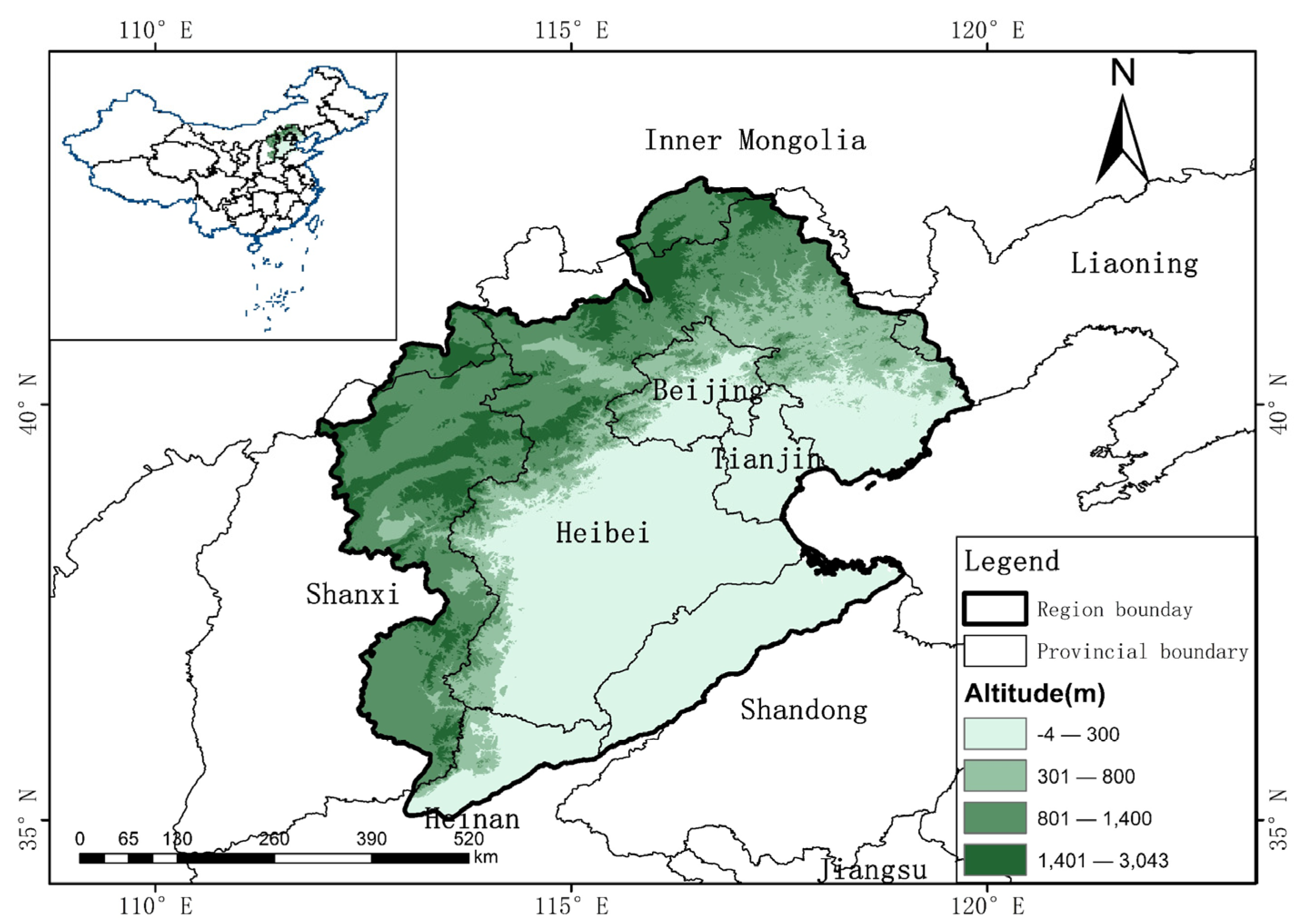
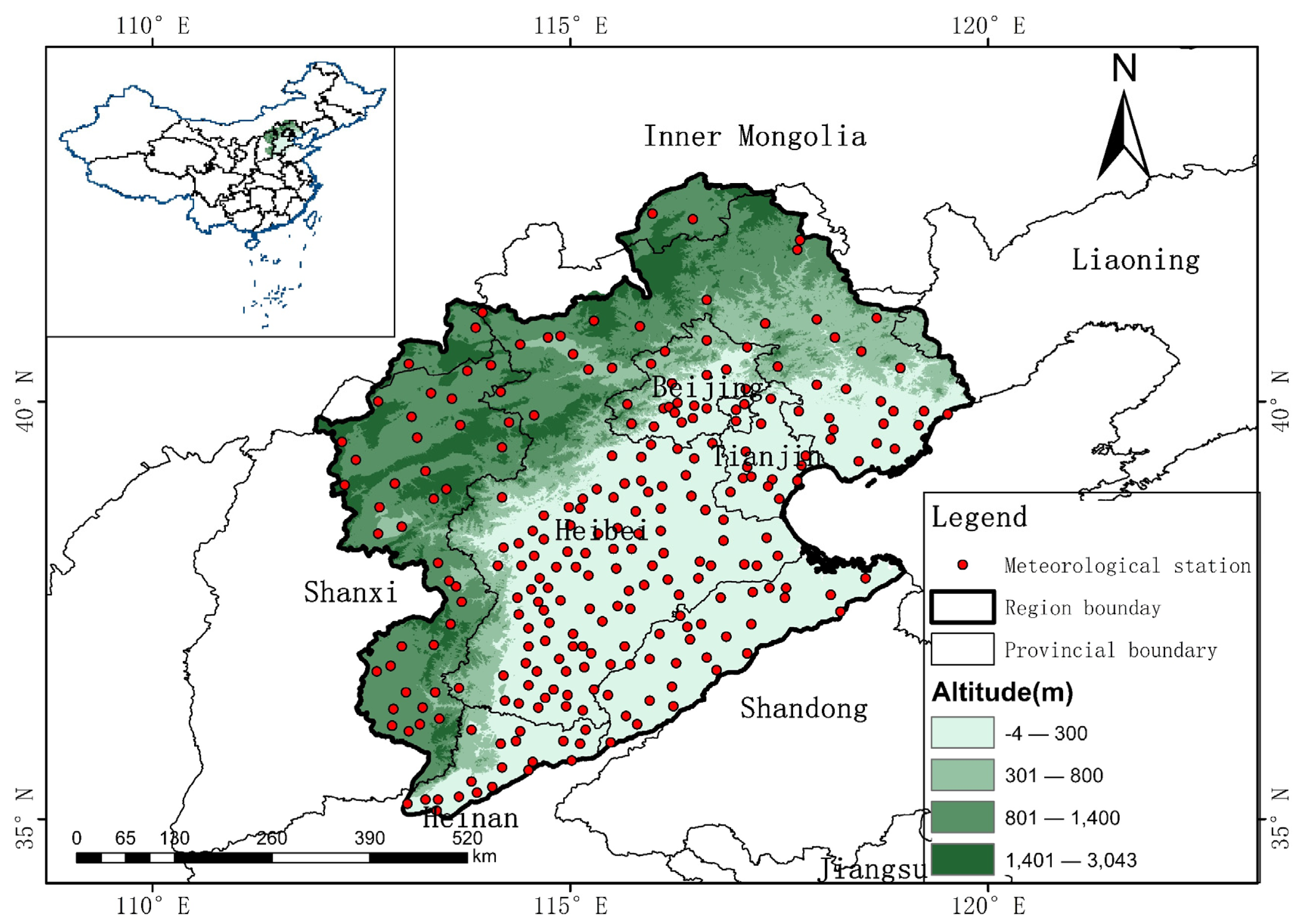
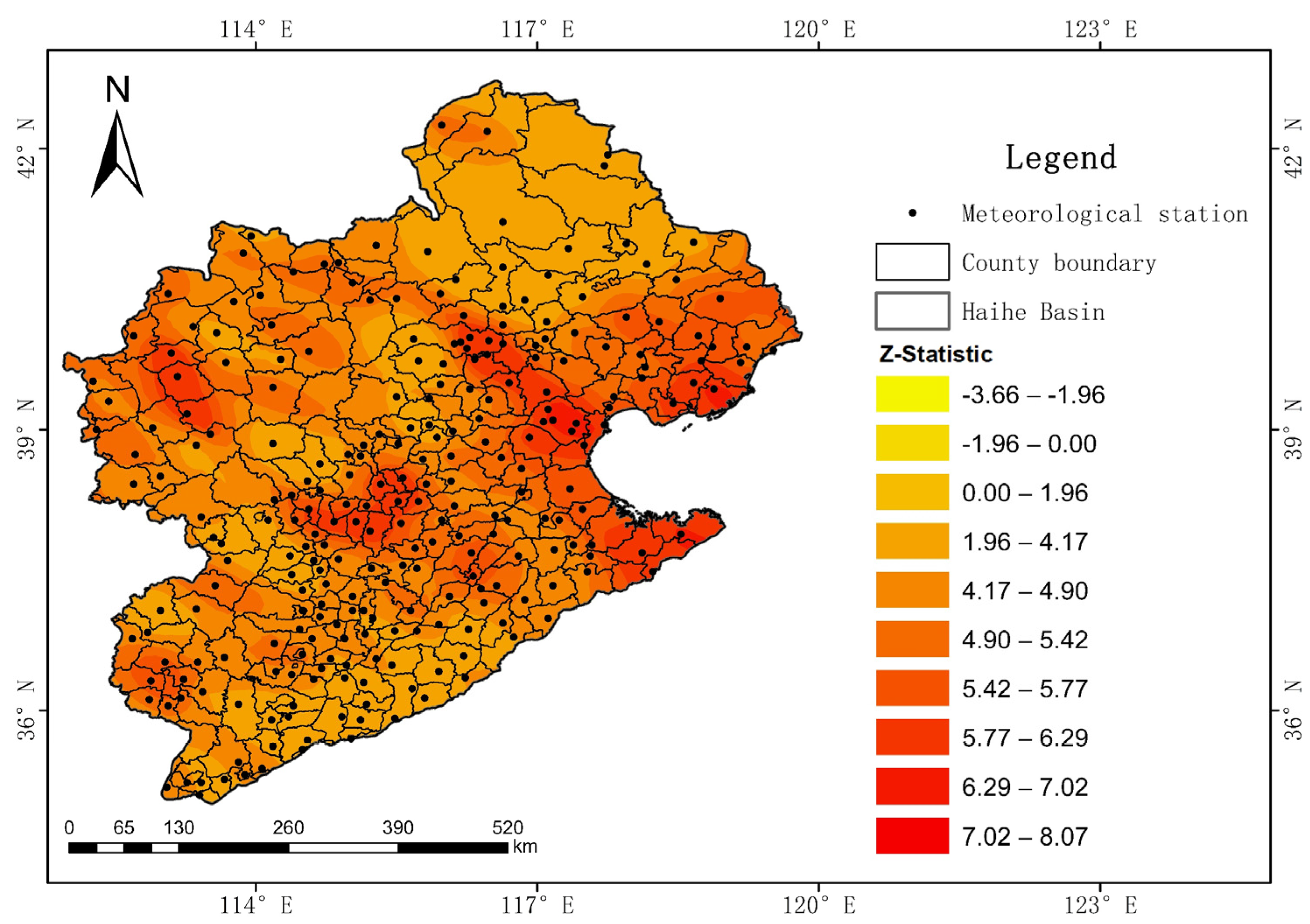
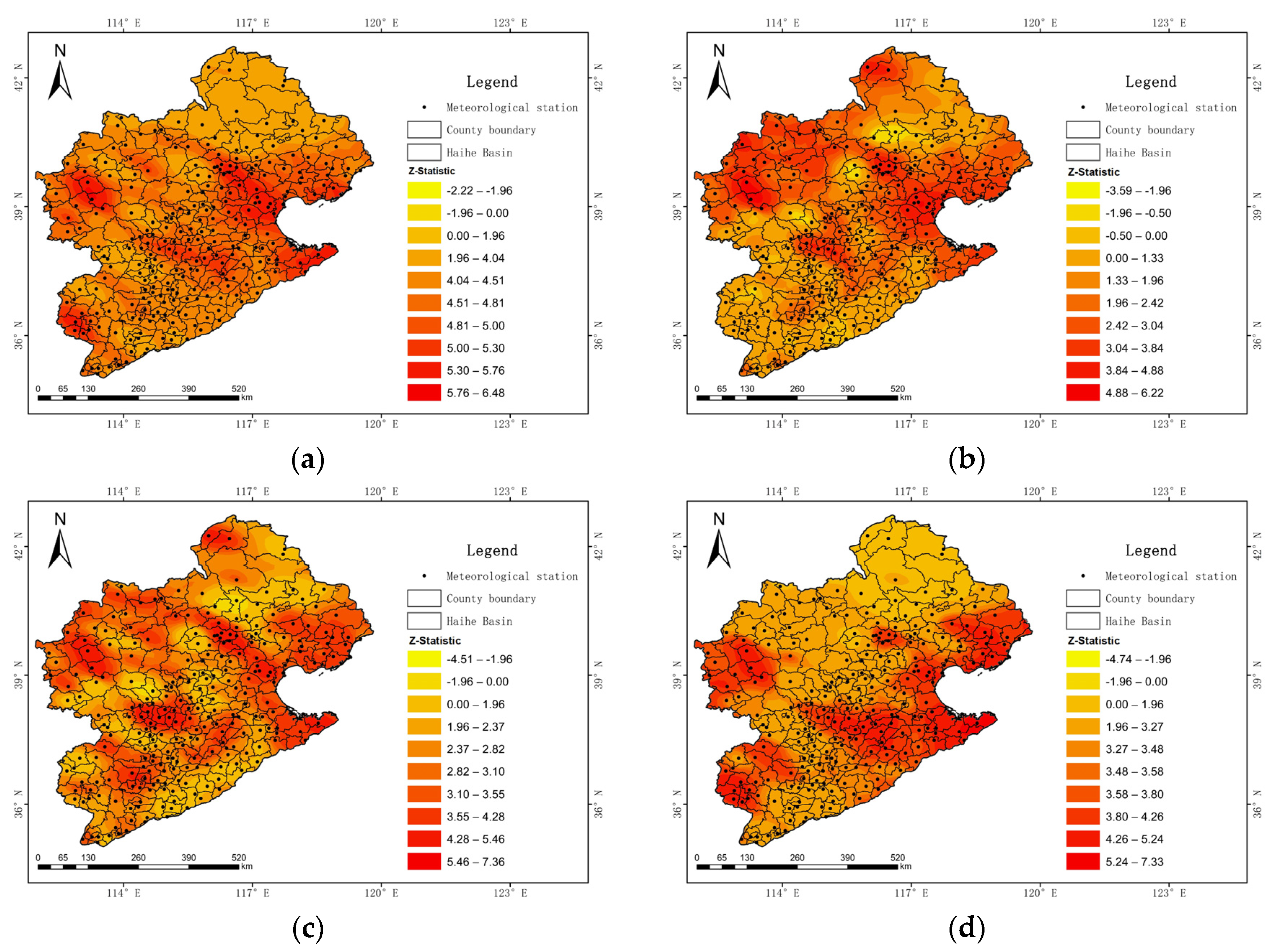
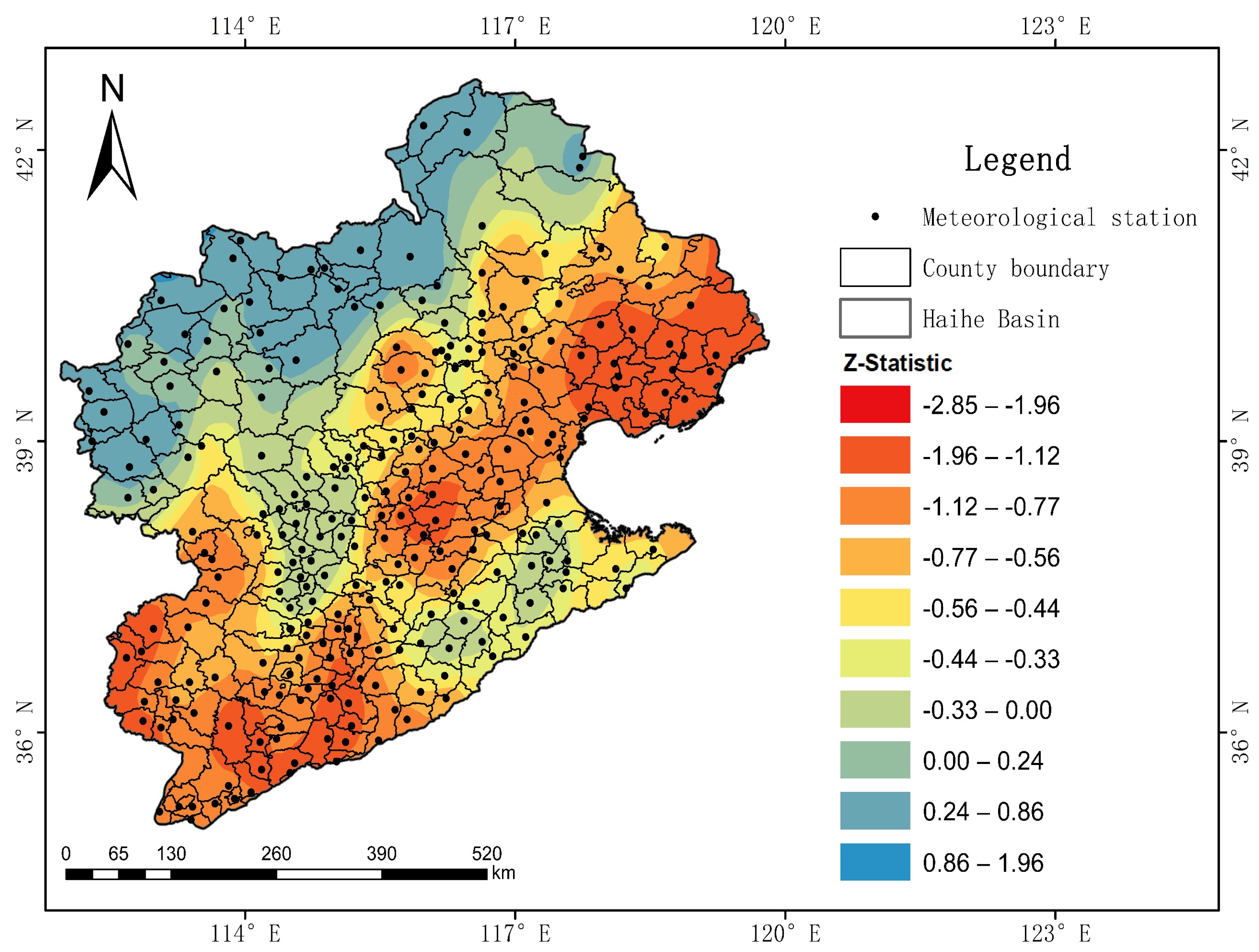
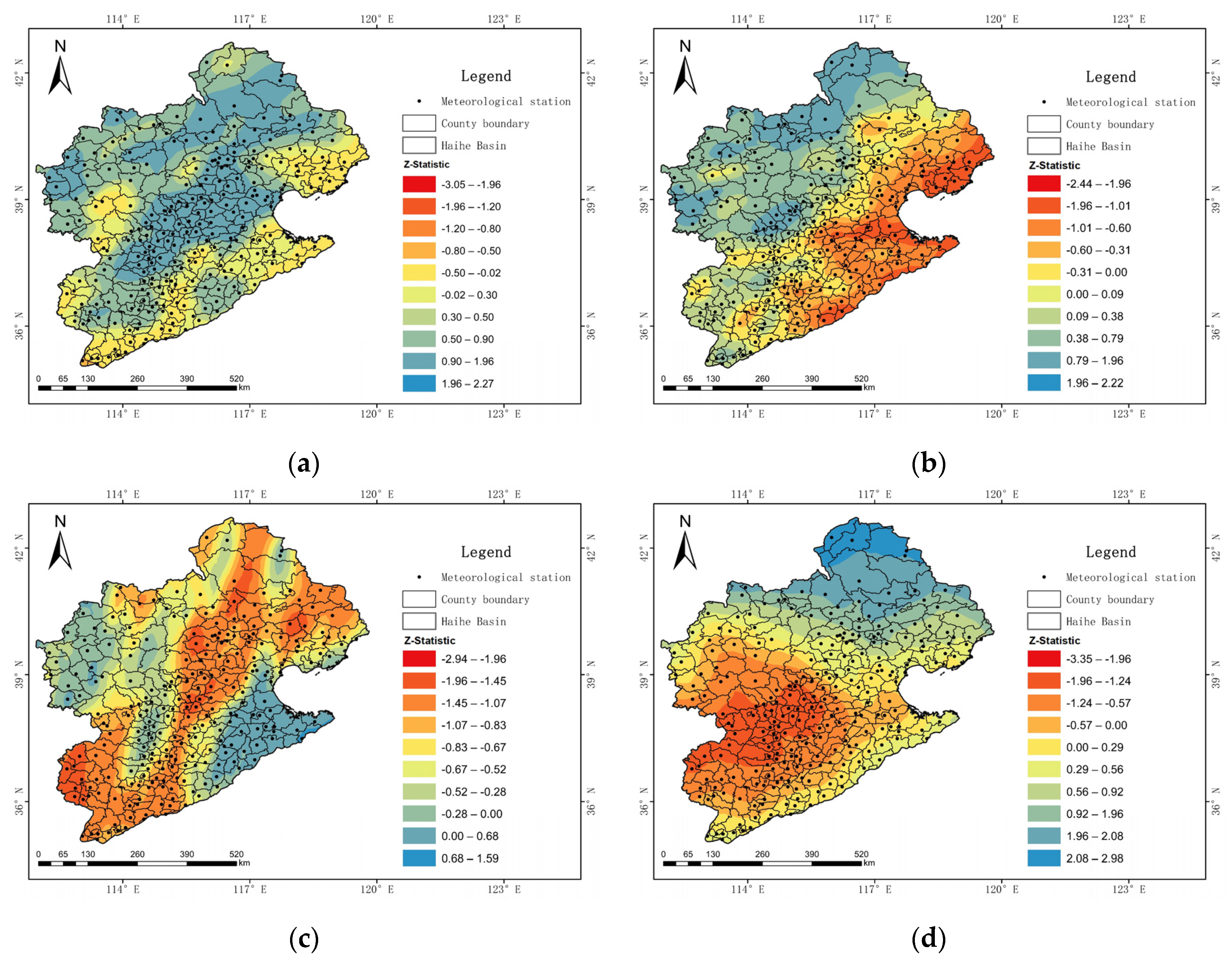
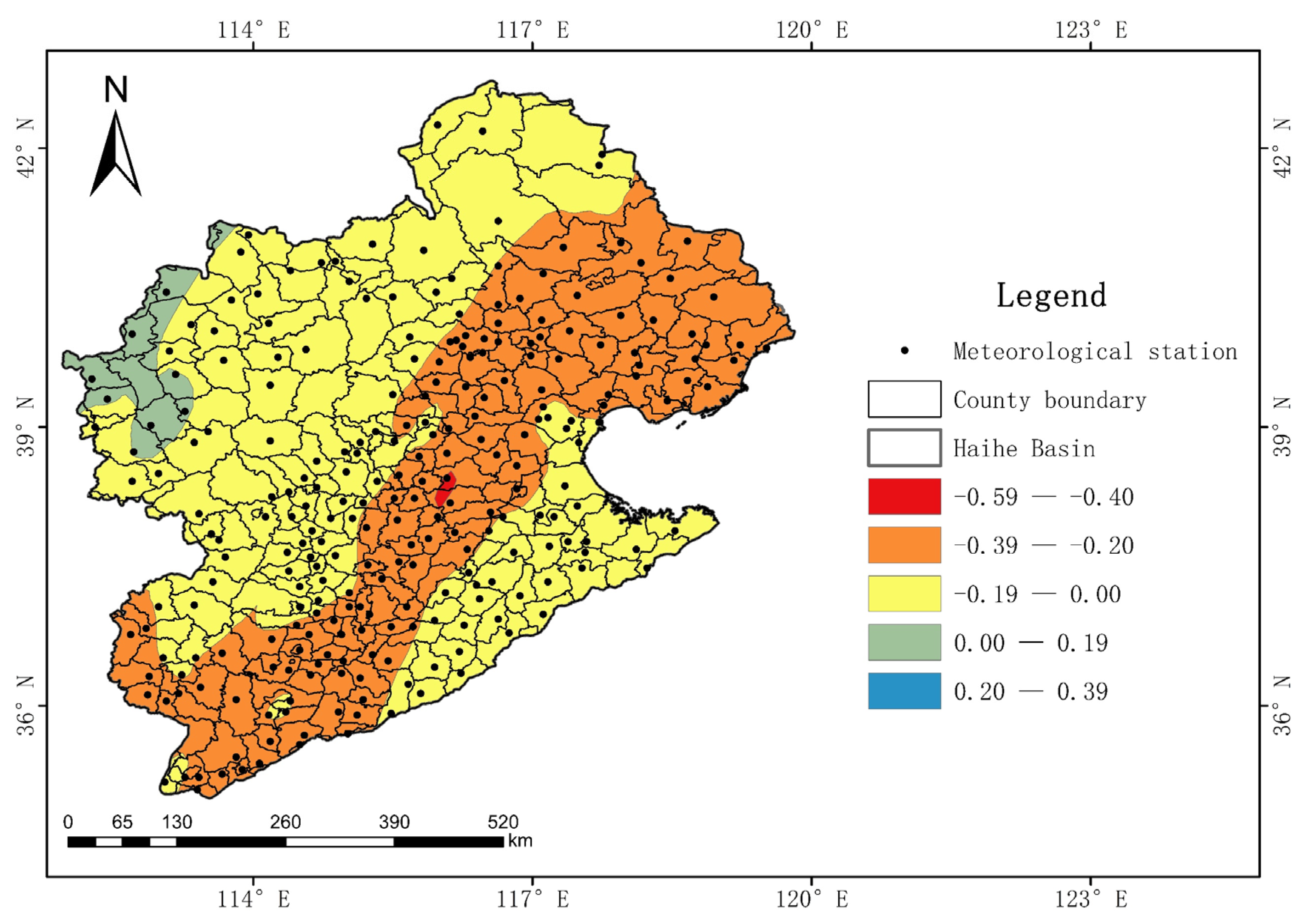
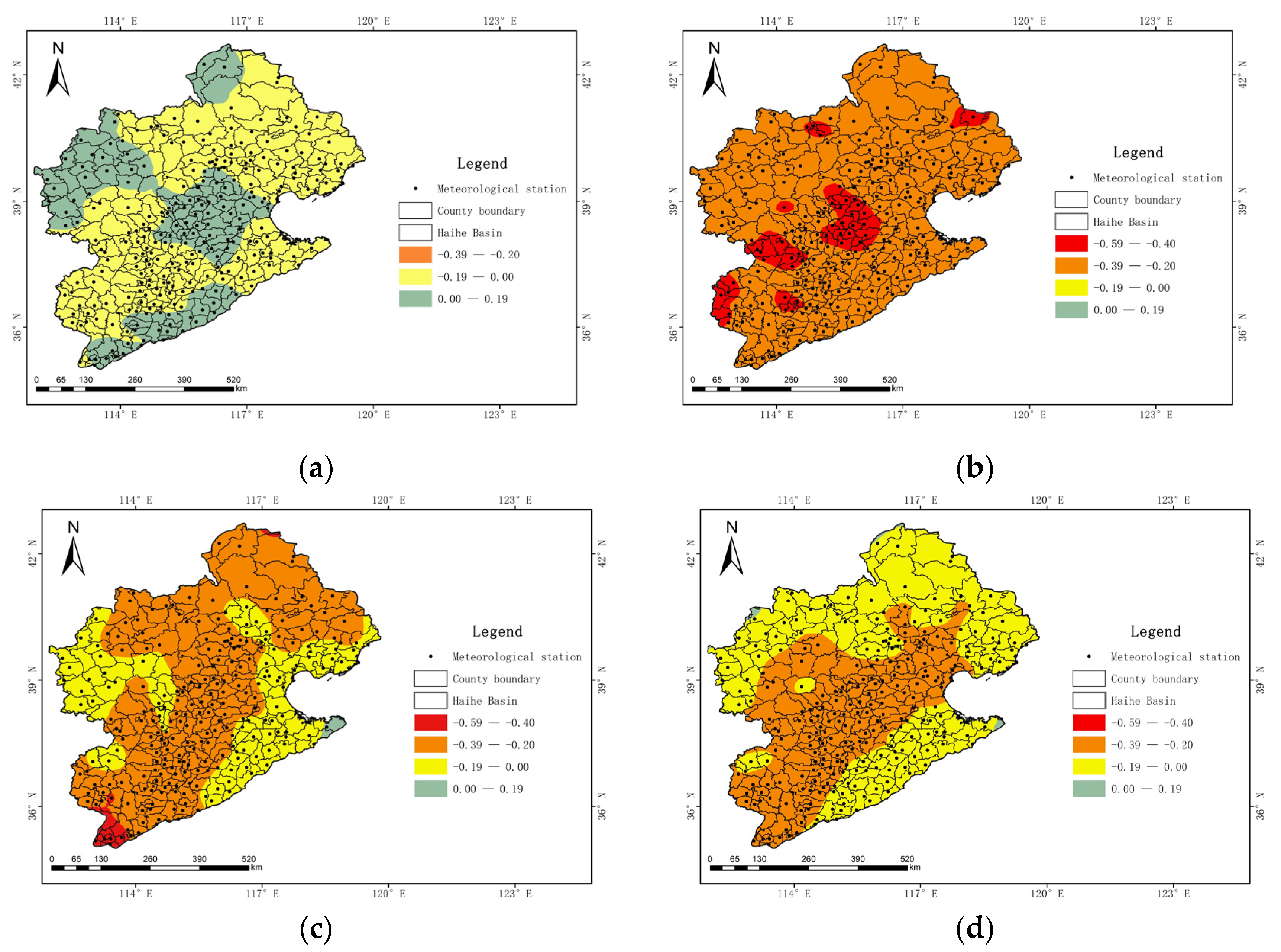
| Correlation Coefficient Value | Degree of Correlation |
|---|---|
| | ρ | = 0 | Completely uncorrelated |
| 0.01 ≤ | ρ | ≤ 0.19 | Weak correlation |
| 0.20 ≤ | ρ | ≤ 0.39 | Low correlation |
| 0.40 ≤ | ρ | ≤ 0.59 | Moderate correlation |
| 0.60 ≤ | ρ | ≤ 0.79 | Significant correlation |
| 0.80 ≤ | ρ | ≤ 0.99 | High correlation |
| | ρ | = 1 | Strong correlation |
| Season | Increasing Trend | Decreasing Trend | ||||
|---|---|---|---|---|---|---|
| Number of Stations | Percentage (%) | Number of Significant Changes | Number of Stations | Percentage (%) | Number of Significant Changes | |
| Spring | 176 | 68.2 | 2 | 82 | 31.8 | 1 |
| Summer | 124 | 48.1 | 2 | 134 | 51.9 | 1 |
| Autumn | 35 | 13.6 | 0 | 223 | 86.4 | 10 |
| Winter | 141 | 54.7 | 4 | 117 | 45.3 | 1 |
| p-Value Range | Nature | Spring | Summer | Autumn | Winter | Interannual Correlation | |||||
|---|---|---|---|---|---|---|---|---|---|---|---|
| Positive | Negative | Positive | Negative | Positive | Negative | Positive | Negative | Positive | Negative | ||
| 0 | Completely non-correlation | 6 | 6 | 0 | 0 | 1 | 0 | 0 | 1 | 0 | 3 |
| 0.01–0.19 | Weak correlation | 90 | 145 | 1 | 15 | 11 | 84 | 3 | 116 | 16 | 111 |
| 0.2–0.39 | Low correlation | 0 | 11 | 0 | 167 | 0 | 141 | 0 | 132 | 1 | 117 |
| 0.4–0.59 | Moderate correlation | 0 | 0 | 0 | 75 | 0 | 21 | 0 | 6 | 0 | 10 |
| 0.6–0.79 | Significant correlation | 0 | 0 | 0 | 0 | 0 | 0 | 0 | 0 | 0 | 0 |
| 0.8–0.99 | Highly correlated | 0 | 0 | 0 | 0 | 0 | 0 | 0 | 0 | 0 | 0 |
| 1 | Completely correlated | 0 | 0 | 0 | 0 | 0 | 0 | 0 | 0 | 0 | 0 |
Publisher’s Note: MDPI stays neutral with regard to jurisdictional claims in published maps and institutional affiliations. |
© 2021 by the authors. Licensee MDPI, Basel, Switzerland. This article is an open access article distributed under the terms and conditions of the Creative Commons Attribution (CC BY) license (https://creativecommons.org/licenses/by/4.0/).
Share and Cite
Han, Y.; Liu, B.; Xu, D.; Yuan, C.; Xu, Y.; Sha, J.; Li, S.; Chang, Y.; Sun, B.; Xu, Z. Temporal and Spatial Variation Characteristics of Precipitation in the Haihe River Basin under the Influence of Climate Change. Water 2021, 13, 1664. https://doi.org/10.3390/w13121664
Han Y, Liu B, Xu D, Yuan C, Xu Y, Sha J, Li S, Chang Y, Sun B, Xu Z. Temporal and Spatial Variation Characteristics of Precipitation in the Haihe River Basin under the Influence of Climate Change. Water. 2021; 13(12):1664. https://doi.org/10.3390/w13121664
Chicago/Turabian StyleHan, Yuhang, Bin Liu, Dan Xu, Chaoguo Yuan, Yanan Xu, Jinxia Sha, Su Li, Yifan Chang, Bolun Sun, and Zhiheng Xu. 2021. "Temporal and Spatial Variation Characteristics of Precipitation in the Haihe River Basin under the Influence of Climate Change" Water 13, no. 12: 1664. https://doi.org/10.3390/w13121664
APA StyleHan, Y., Liu, B., Xu, D., Yuan, C., Xu, Y., Sha, J., Li, S., Chang, Y., Sun, B., & Xu, Z. (2021). Temporal and Spatial Variation Characteristics of Precipitation in the Haihe River Basin under the Influence of Climate Change. Water, 13(12), 1664. https://doi.org/10.3390/w13121664






